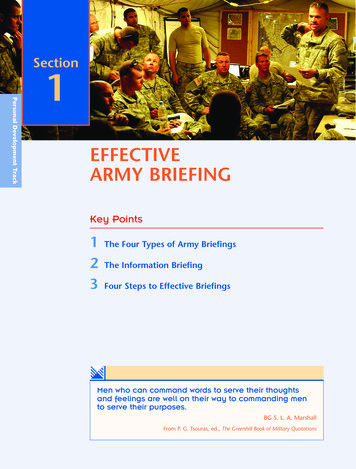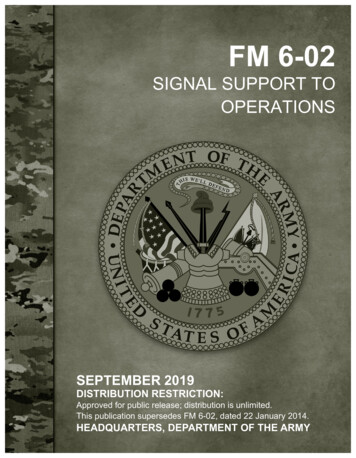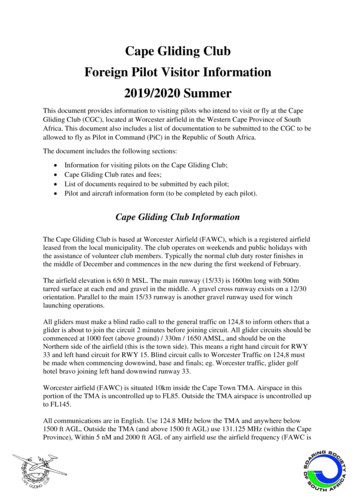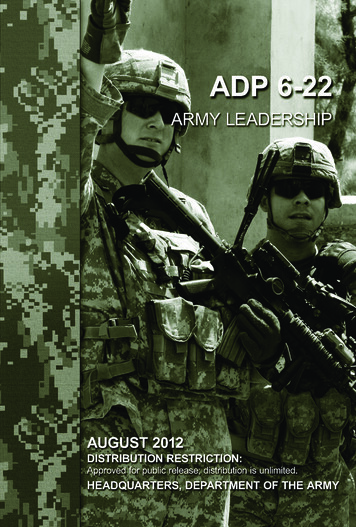
Transcription
SectionPersonal Development Track1EFFECTIVEARMY BRIEFINGKey Points123The Four Types of Army BriefingsThe Information BriefingFour Steps to Effective BriefingseMen who can command words to serve their thoughtsand feelings are well on their way to commanding mento serve their purposes.BG S. L. A. MarshallFrom P. G. Tsouras, ed., The Greenhill Book of Military Quotations
Effective Army Briefingn71IntroductionBriefings are the most efficient and common means to present information tocommanders, staffers, Soldiers, or other specified audiences. You conduct briefingswhen your listeners need information quickly, when they can get together conveniently,and when they need to decide how to act on that information. Briefings are oftenpreferred to written or even electronic communication because they are direct,immediate, and interpersonal. When lives may be at stake and units must carry outthe right decisions, most decision makers prefer the immediate physical setting ofthe military briefing.While this lesson focuses on the development of briefing skills for leaders,you must keep in mind that communication is a two-way process. The speaker hasa responsibility to clearly present the material, and this involves knowing the needsand expectations of the audience. But the listener also has responsibilities—not onlyto listen, but to provide feedback to the speaker to confirm that the message hasbeen received and understood. As you’ll learn in the next section, leaders not onlyspeak, they listen!This section will briefly introduce you to the four basic types of Army briefings.The most fundamental, the information briefing, aims to inform the listener andgain his or her understanding. The second type, the decision briefing, aims to obtainan answer or a decision. A commander or staff officer usually presents the third, themission briefing—typically in critical situations to reinforce decisions or orders andto provide details and guidance necessary for the mission’s success. The fourth typeis the staff briefing, focused on ensuring a coordinated or unified effort amongcommanders and staffers responsible for various aspects of a mission.You must be able to decide which type of briefing and which techniquesto use depending on the situation, the briefing’s purpose, the response you want,and your role and mission as briefer.The ability to construct and deliver an effective briefing is a fundamental leadershipaction. As a Cadet with the immediate goal of building effective communication skills,you will begin with the information briefing. The goal of military information briefingsis to enable sound decisions and problem solving. Therefore, the information must becurrent, accurate, clear, and credible. It must also meet the needs and expectations ofyour audience. Your analysis of facts and opinions must be convincing and thorough.The ability to deliver information clearly and confidently is as much a leader skillas making a motivational speech to Soldiers who are about to depart on a dangerousmission. One of the best ways to become an effective briefer is to study military leaderswho are noted for their ability to assess the needs of the audience, adapt informationand communication style, and present ideas clearly.briefingsbriefings are a wayto present informationto commanders, staffers,or other designatedaudiences—you decidewhich techniques touse depending on thepurpose of the briefing,the response you want,and the briefer’s role
72nSECTION 1The Four Types of Army BriefingsThere are four types of Army briefings: the information briefing, the decision briefing, themission briefing, and the staff briefing. They are briefly described below.1. Information Briefing. The information briefing delivers information in a form theaudience can understand and use. It does not include conclusions or recommendations.It does not require decisions.2. Decision Briefing. A decision briefing obtains an answer to a question or results in adecision on a course of action. It presents the recommended solution resulting fromanalysis or study of a problem or problem area. Decision briefings vary in formalityand detail, depending on the level of command and the decision makers’ knowledgeof the subject.3. Mission Briefing. A mission briefing’s goal is to secure a coordinated or unified efforttoward accomplishing the mission. It often involves the exchange of information,the announcement of decisions within a command, the issuance of directives, or thepresentation of guidance.4. Staff Briefing. The staff briefing may have characteristics of information briefings, decisionbriefings, and mission briefings. The purpose of a staff briefing is to coordinate unit effortsby informing the commander and staff of the current situation. The person who convenesthe staff briefing sets the agenda. Staff representatives each present relevant informationfrom their functional areas. Staff briefings may involve exchange of information,announcement of decisions, issuance of directives, or presentation of guidance.The Information BriefingThe information briefing focuses on the clear and useful communication of facts andinformation. The information will always have a background: how current it is, howreliable it is, and why you are communicating it—including how it meets the needs andexpectations of those you are briefing. Examples of information appropriate for aninformation briefing include: high-priority or time-sensitive information requiring immediate attention complex information, including complicated plans, procedures, systems, situations,statistics, and charts requiring detailed explanation controversial information requiring elaboration and explanation.Since the information briefing’s intent is to inform the audience as efficiently as possible,you will use a standard format.The Format for an Information Briefing1. Introduction Greeting. Address the person(s) you are briefing. Identify yourself and yourorganization. “Good morning, Colonel Jones. I’m Lieutenant Kelly, the AssistantS3 of the 1st Battalion 502d Infantry.” Type and Classification. Explain the briefing’s classification. “This is a SECRETinformation briefing,” or “This is an UNCLASSIFIED information briefing.” Purpose and Scope. State the purpose first: Explain your briefing’s purpose andscope. “The purpose of this briefing is to bring you up to date on the companyperimeter defense plan,” or “I will cover the operations plan for FTX Team Spirit.”
Effective Army Briefingn73 Outline or Procedure. Briefly summarize the main point, key supporting points,and your general approach. Explain any special procedures (demonstrations,displays, or tours). Example: “During my briefing, I’ll discuss the four phases of ourplan. I’ll refer to maps of our sector, and then my assistant will bring out a sandtable to show you the expected sequence of the movement to contact.”2. BodyArrange the main points in a logical sequence. Use visual aids correctly to emphasizeyour main and supporting ideas. Plan effective transitions from one main point to thenext. Be prepared to answer questions at any time.3. ClosingAsk for questions. Briefly restate your main ideas and make a concluding statement.Four Steps to Effective BriefingsCareful preparation is the key to effective briefings, whatever the purpose. Once you’vebeen tasked to present a briefing, you should begin to prepare immediately by analyzingthe situation—including your intent—and your audience’s needs and expectations.1. Analyze the SituationWithout an analysis of the briefing situation and a resulting plan for constructing anddelivering the briefing, you will waste time and risk failure. Unlike a document, a briefinghappens at a specific place and time. If all aspects of the briefing, including the content andthe delivery, are not carefully coordinated, you may not effectively communicate. You beginto analyze the situation by focusing on the purpose, audience, and the occasion by asking: What is my intent or purpose for briefing?Whom am I briefing?How well does the audience know the subject?What does the audience expect from me?What information does it need?Before briefing an audience, you must learn about its needs and expectations. Will youraudience be relaxed or impatient? Are you a credible presenter or do you need to establishcredibility? Are you there to present facts or to make a recommendation? You must understandhow your audience’s traits relate to the intent and purpose of the briefing. The purposedetermines what kind of briefing you present. The time allocated, audience, and location willhelp you determine the amount of effort and time needed to prepare. Always check on theavailability of physical facilities, visual aids, and other support as early as possible.Once you have analyzed your intent, purpose, and audience, you should prepare adetailed presentation plan. You should also carefully schedule your preparation milestonesand formulate a briefing outline, which you will fully develop during the constructionphase. Finally, you initially estimate the deadlines for each task, schedule facilities forrehearsal, and request critiques from others.2. Construct the BriefingWhen constructing a briefing, it is useful to follow a systematic process of researching, organizing,drafting, revising, and proofing. Here are the major steps in constructing an effective briefing:ResearchResearching for a military briefing is frequently “capturing what you know” by bringingtogether the information you have gathered from various sources. Use brainstormingA briefing assignmenthas four steps thatcorrespond to thefour activities of theoperations process:Plan: Analyze thesituation and preparea briefing outlinePrepare: Constructthe briefingExecute: Deliverthe briefingAssess: Follow up.Always check on theavailability of physicalfacilities, visual aids,and other supportas early as possible.
74nSECTION 1and mind-mapping to help you collect information focused on your purpose and audience.When researching, you: collect material ensure you know the subject thoroughly ensure you have enough (but not too much) information.OrganizeIn organizing, you sort all the information gained during your research. You then arrangethe information to best suit your purpose. You should also answer these questions: Whichparts of the information are of major concern? Which are minor? What should come first?Last? What are the logical connections?When you organize, your objective is to create your main point—your controllingidea—as a simple statement summarizing the key information from your research. Thenyou should create two to five statements that directly support the controlling idea andeffectively cover the key information. These are your “bottom line” and main supportingpoints, and they should always be stated at the beginning of the briefing.Test and revise both your substance and organization. Eventually you’ll find theinformation that’s needed to properly focus your ideas for the audience and answer allpotential questions and objections. While organizing, you should also choose your visualaids to suit the situation and begin to consider how you will deliver your information inthe time available. In other words, when organizing, you: isolate key pointsarrange key points in logical orderensure you have supporting data to validate the key pointsselect visual aids.The goal of all this labor is an outline that is easy to transform into a draft.DraftIn the draft you put your ideas into words (and onto visuals)—this is your first effort atfull expression. Write out whatever you’ve outlined during organizing, but—unless thesituation requires it—avoid writing a script. A script tends to make your delivery inflexible.Concentrate on how you will communicate your controlling idea, your main points, andyour supporting evidence. Focus on the substance you’ve created and its organizationand choose the wording that will best communicate with your audience. Coordinate thetext of your draft with your visuals, demonstrations, or other activities.Revising, Proofing, and RehearsingAfter letting your draft “cool,” it’s useful to revise your briefing to make sure the vocabularyis suitable for the audience. In this regard, you should replace any jargon that listeners maynot understand with terms that are familiar to them. After revising, you should proofread(“proof”) for both the oral and written components of the briefing. Check and confirmpronunciation of words, including individuals’ names and place names, and carefully proofall handouts and visuals. To confirm pronunciation and spelling, use standard referencessuch as a current collegiate dictionary and a collegiate grammar handbook.To ensure the effective delivery of an information or other type of briefing, there is simplyno substitute for rehearsing with colleagues who can act the part of the audience and provideyou with useful feedback. You should time your rehearsals, and, if possible, rehearse in thelocation in which you will deliver the briefing. The closer your rehearsal can be to the realthing, the greater will be your confidence and the better your performance under pressure.
Effective Army Briefingn753. Deliver the BriefingWhen delivering the information briefing, a key is to understand whether you are gettingthrough to your audience. Therefore, it is critical to maintain eye contact throughout theaudience, throughout the entire briefing. A second key is to be perceived as a credible briefer.Recognize that as a junior leader, no one is going to expect you to speak like a seasonedsenior officer, nor is it appropriate for you to do so. Be confident, but never try to comeacross as infallible, which others will often see as arrogance. Effective briefers typicallycombine these traits—they are: .While you are delivering the briefing, you must: present the subject as intended and ensure that the audience understands itbe briefspeak to express your points and information, not impress the audienceuse visuals and other aids to clarify, not entertainbe ready for interruptions and questions at any point.4. Follow UpWhen the briefing is over, it is important to prepare a memorandum for record (MFR)to record the subject, date, time, and place of the briefing and the ranks, names, andpositions of those present. For an information briefing, concisely provide the content ofthe briefing. For other types of briefings, you include recommendations and their approval,disapproval, or approval with modification, as well as any instruction or directed action,as appropriate. You should distribute the MFR to those who must act on the informationand to those whose operations or plans the briefing’s contents may influence.eCritical ThinkingWhat are some similarities and differences between preparing and deliveringpresentations in your college studies and Army briefings?eCritical ThinkingDivide a sheet of paper into two columns. Label one column “Characteristicsof an Effective Briefer.” Label the other “Characteristics of an Ineffective Briefer.”In the two columns, list and briefly explain what you believe to be five or moreimportant characteristics of successful and unsuccessful briefings. Then analyzeyour own strengths and weaknesses as a speaker, and think about how to improve.memorandumfor record (MFR)a report recording thesubject, content, date,time, and place of abriefing and the ranks,names, and positionsof those present
76nSECTION 1eCONCLUSIONIn the Army, and especially in the rapidly changing Contemporary OperatingEnvironment, a leader must know what’s going on and what needs to be done.Leaders must also be able to communicate their intent to others. It is especiallycritical that you, as a junior leader, be able to efficiently and accuratelycommunicate information to your superiors and your Soldiers—whether thatinformation is the enemy’s current location and strength; the commander’sintent for accomplishing the mission; or the plan of actions your unit musttake upon seizing an objective.In spite of today’s technology, there is no more effective or immediatemethod of communicating information than the briefing. To develop as a leader,you must develop your abilities as an effective briefer. Consider supplementingthe communications skills instruction and practice you receive as part of yourROTC studies with a public speaking course at your college and participationin organizations such as Toastmasters (www.toastmasters.org).Also recognize that development of your speaking and writing skills iscomplementary when you focus on the Army’s “corporate standard” forcommunication. The standards for Army briefings are essentially the same asfor effective Army writing: “clear, concise, organized, and right to the point.”To implement the standard, put your main points up front, use the activevoice, use simple words and phrases, use shorter sentences and paragraphs,and package your information for quick understanding. Following theseguidelines, your briefings will succeed, and you will set the standardsfor those you lead.Key Wordsbriefingsmemorandum for record (MFR)
Effective Army BriefingLearning Assessment1. What are the four types of military briefings and how do youdistinguish among them?2. In what way is the information briefing the most fundamentalof the four types?3. What are the four steps you must take to brief effectively?ReferencesDA PAM 600-67, Effective Writing for Army Leaders. 2 June 1986.Field Manual 5-0, Army Planning and Orders Production. January 2005.Field Manual 6-22, Army Leadership: Competent, Confident, and Agile. 12 October 2006.ST 22-2, Writing and Speaking Skills for Leaders at the Organizational Level. August 1998.Tsouras, P. G., ed. (2000). The Greenhill Book of Military Quotations. Mechanicsburg,PA: Stackpole Books.n77
1 The Four Types of Army Briefings 2 The Information Briefing 3 Four Steps to Effective Briefings EFFECTIVE ARMY BRIEFING e Men who can command words to serve their thoughts and feelings are well on their way to commanding men to serve their purposes. BG S. L. A. Marshall From P. G. Tsouras, ed., The Greenhill Book of Military Quotations










